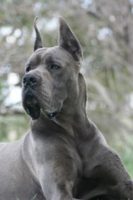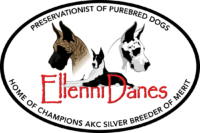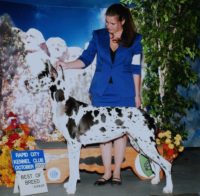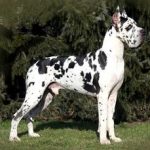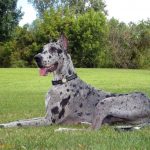 The Great Dane is a popular breed of dog that originated in Germany. They are known for being some of the largest breeds of dogs. Because of that are a large part of pop culture. Both Marmaduke and Scooby-Doo are extremely well known great danes. Also famous is Hagrid’s dog Fang from the Harry Potter series. The blue merle Great Dane has a striking appearance and is also represented in many Great Dane depictions.
The Great Dane is a popular breed of dog that originated in Germany. They are known for being some of the largest breeds of dogs. Because of that are a large part of pop culture. Both Marmaduke and Scooby-Doo are extremely well known great danes. Also famous is Hagrid’s dog Fang from the Harry Potter series. The blue merle Great Dane has a striking appearance and is also represented in many Great Dane depictions.
The Great Dane has known several different names over time, including “German Boarhound,” “German Dogge,” and “German Mastiff.” Though they are extremely large, these dogs are often referred to as “gentle giants” due to the fact that they are very friendly and fond of affection. Their large size can often be seen as intimidating, they are very gentle dogs and do not tend to exhibit any aggressive behavior.
Humorously, despite their large size, they enjoy leaning on and sitting on their owners. This has earned the Great Dane the nickname of “the world’s biggest lapdog.”
Blue Merle Great Dane Acceptance
Among Great Danes, the blue merle pattern is not one of the American Kennel Club (AKC) officially recognized colors. It is a popular one nonetheless due to it’s beauty and unique appearance. The merle pattern can also occur in several other breeds including the Australian Shepherd, Collie, and Shetland Sheepdog. This color is one of the more recognizable ones, and features black spots on a lighter blue-gray coat.
Merle coloration is often considered a “mismark” of harlequin patterned litters. The term “mismark” in this case simply refers to the fact that it is not a standard AKC recognized color. Even though the merle pattern is not an officially recognized color, owners of merle patterned Great Danes can still register their purebred dogs with the American Kennel Club. The non-recognition of the color simply means that the dog cannot be shown as the color is not part of the breed standard.
The merle pattern is recognizable by darker spots on a lighter coat. It can appear in several different colors, depending on the coat colors that are bred to achieve them. Blue merles are generally marked by a slate colored coat, though merles can appear in many different coat colors. Fawn (light cream to tan), chocolate (reddish), brindle (stripes incorporated into merle coloration), mantle (light to dark gray), silver or platinum (light silver/gray), and tri-colored (three distinct coat colors) merles are all possible colors along with blue.
“Blue” Merle Name
The “blue” merle name comes from the fact that when black coat color is diluted, it appears to be a bluish gray color. This makes the nose pigmentation appear bluish black. It also causes the lighter coat color to appear to have more blue undertones instead of simply neutral gray. Merle Danes can occasionally have white markings in a similar way to standard-colored Danes. White markings can be present on the chest and feet. The characteristic white markings that are a trademark of the “mantle” pattern can appear as well.
The Blue merle Great Dane coat color is popular due to the fact that every merle colored Great Dane is unique. Some unethical breeders will attempt to market the merle coat pattern as “rare”. Prospective dog owners should be warned that the color is not actually all that rare. Versions of merle exist that are combinations of other color patterns, for example the “merlequin” color is a combination of merle coloration and the harlequin coat pattern, which is characterized by a mostly white body with large dark spots.
Blue Merle Great Dane Breeding
Even though they are beautiful, blue merle and other merle patterned Danes should not be bred. Merle patterned Great Danes can be very healthy dogs, but breeding two merle dogs together can be risky. Puppies with two merle genes (one from each parent) can potentially cause health problems. Many consider breeding two merle Danes an unethical practice due to the complications that can result in puppies that possess the “double merle” genes. It is considered better to spay or neuter merle colored Danes as their puppies can be deaf, blind, or even stillborn.
